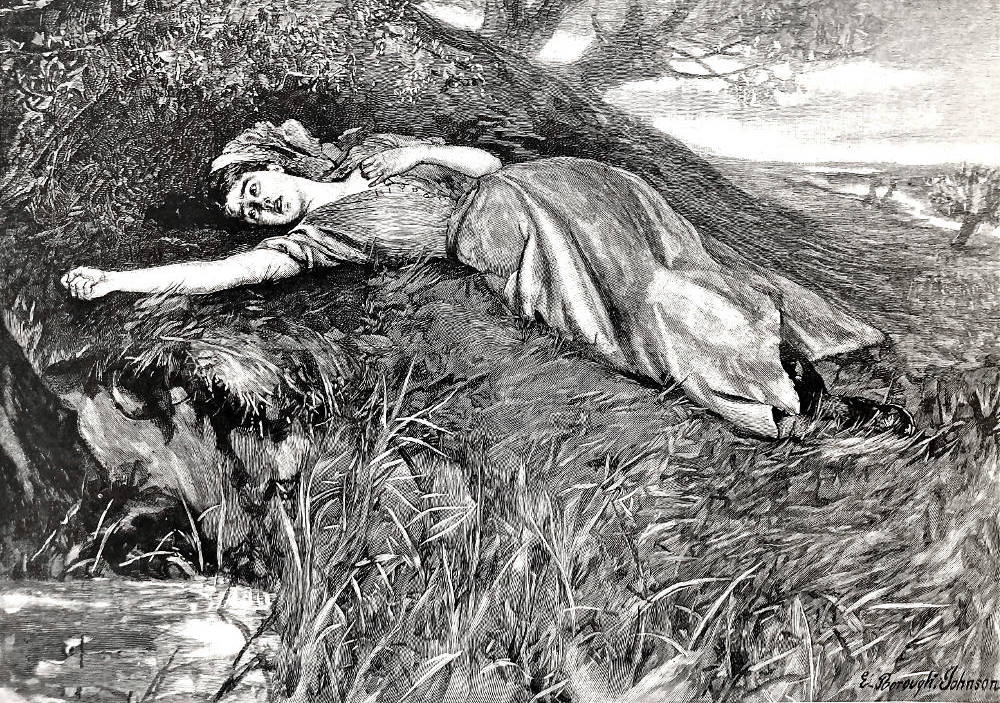
Tess flung herself upon the undergrowth of rustling spear-grass as upon a bed by E. Borough Johnson. Plate 11 from the weekly serialisation of Thomas Hardy's Tess of the D'Urbervilles in the London Graphic, 19 September 1891; [Tess solo in Ophelia pose, after she has promised to give Angel an answer to his proposal] p. 330, bottom of column 2 (towards the end of Ch. XXVII, the picture appearing above the start of Ch. XXVI), half-page, horizontal: 16 cm high by 22.5 cm wide (6 ½ inches by 8 ⅞ inches wide), framed. [Click on the illustration to enlarge it.]
Passage Illustrated: Tess Acquiesces in Angel's Marriage Proposal
“I will try — not! And I’ll give you my reasons to-morrow — next week.”
“Say on Sunday?”
“Yes, on Sunday.”
At last she got away, and did not stop in her retreat till she was in the thicket of pollard willows at the lower side of the barton, where she could be quite unseen. Here Tess flung herself down upon the rustling undergrowth of spear-grass, as upon a bed, and remained crouching in palpitating misery broken by momentary shoots of joy, which her fears about the ending could not altogether suppress.
In reality, she was drifting into acquiescence. [Book Third, "The Rally," Chapter XXVII, 330; in the 1897 volume edition, Phase the Fourth, "The Consequence," Chapter XXVIII, 231]
Commentary: A Fugue State
Thrown into terrible indecision as to whether to accept Angel's proposal, made without knowledge of her sexual history (vague enough in the serial), Tess enters a a fugue state. Tess in Borough Johnson's series has developed from a round-cheeked adolescent in a mature and gracefully proportioned womanhood. While Angel must consult his parents about his marriage plans and his emigration scheme, Tess communes with herself in this eleventh plate, almost half-way through the series. Having refused his initial proposal, ostensibly as a result of their differences in class, she has vaguely alluded to her prior "experiences," but finally agrees to give her suitor a definitive answer in four days. Her instincts are now overwhelming her "scrupulousness" as she seriously contemplates doing what is natural (as Borough Johnson emphasizes by the tranquil, idyllic setting): she determines "to snatch ripe pleasure before the iron teeth of pain" (XXVII: 330).
Hardy gives the illustration some context. She is lying among the willows, close enough to the dairy barns to hear "the rattle of pail;s when taken down from the forked stands"; and yet she is overwrought by Angel's insistent proposal, and avoids her milking duties in order to hide her "agitation" from her fellow milkmaids. The illustrator renders a Tess wracked by self-doubts which mingle with a fancied future as the wife of a handsome and utterly devoted member of the upper-middle class.
Though the engraving is not noteworthy for its lines or even for his [Borough Johnson's] handling of Tess's reclining figure (since it seems mechanical and awkward), it stresses a loneliness and suffering even in the rural harmony of Talbothays and reminds the viewer that Tess's past is an important and continuing element in the story. As mood painting, the illustration is effective, and conveys a Pre-Raphaelite quality. [Jackson, pp. 109-110]
Although the illustrator evokes through the figure's pose and setting a number of PRB compositions, one suspects that Borough Johnson had in mind John Everett Millais' Ophelia (1851-52), oil on canvas, realising her narrated death in Hamlet, IV, iii.
Note: Johnson's next illustration for Tess of the D'Urbervilles in this serialisation can be seen here, a little later in the sequence of Johnson's own work. For commentaries on all the illustrations of the serial, including earlier ones by Johnson, and others by different hands, please consult the complete list.
Scanned image and text by Philip V. Allingham. You may use this image without prior permission for any scholarly or educational purpose as long as you (1) credit the person who scanned the image, and (2) link your document to this URL in a web document or cite the Victorian Web in a print one.
Bibliography
Allingham, Philip V. "The Original Illustrations for Hardy's Tess of the D'Urbervilles Drawn by Daniel A. Wehrschmidt, Ernest Borough-Johnson, and Joseph Sydall for the Graphic (1891)." The Thomas Hardy Year Book, No. 24 (1997): 3-50.
Allingham, Philip V. "Six Original Illustrations for Hardy's Tess of the D'Urbervilles Drawn by Sir Hubert Von Herkomer for the Graphic (1891)." The Thomas Hardy Journal, Vol. X, No. 1 (February 1994): 52-70.
Hardy, Thomas. Tess of the D'Urbervilles in the Graphic, 1891, 4 July-26 December, pp. 11-761.
Hardy, Thomas. Tess of the D'Urbervilles: A Pure Woman. Vol. I. The Wessex Novels.London: Osgood, McIlvaine, 1897.
Jackson, Arlene M. Illustration and the Novels of Thomas Hardy. Totowa, NJ: Rowman and Littlefield, 1981.
Vann, J. Don. "Tess of the D'Urbervilles in the Graphic, 4 July — 26 December 1891." Victorian Novels in Serial. New York: MLA, 1985, pp. 88-89.
Created 5 December 2000
Last modified 6 May 2024